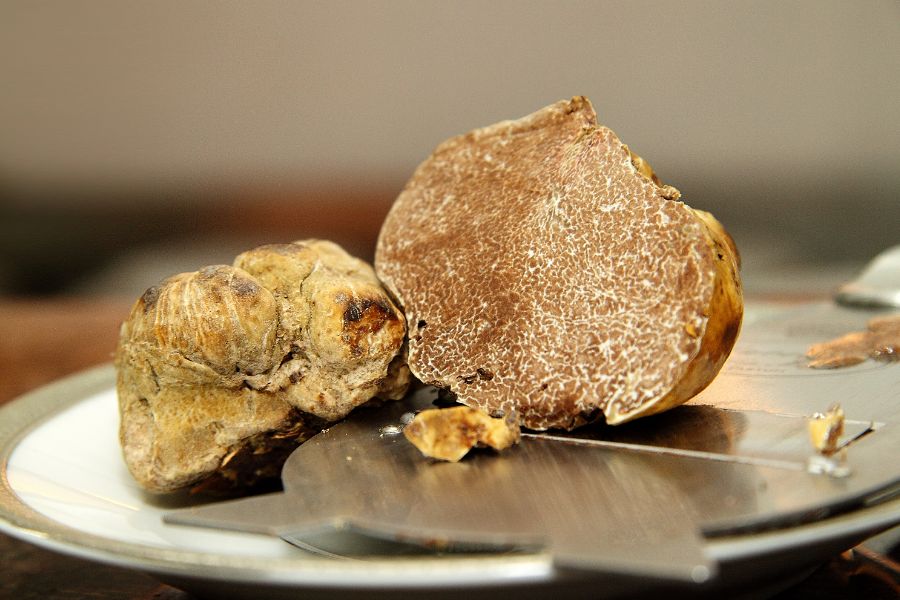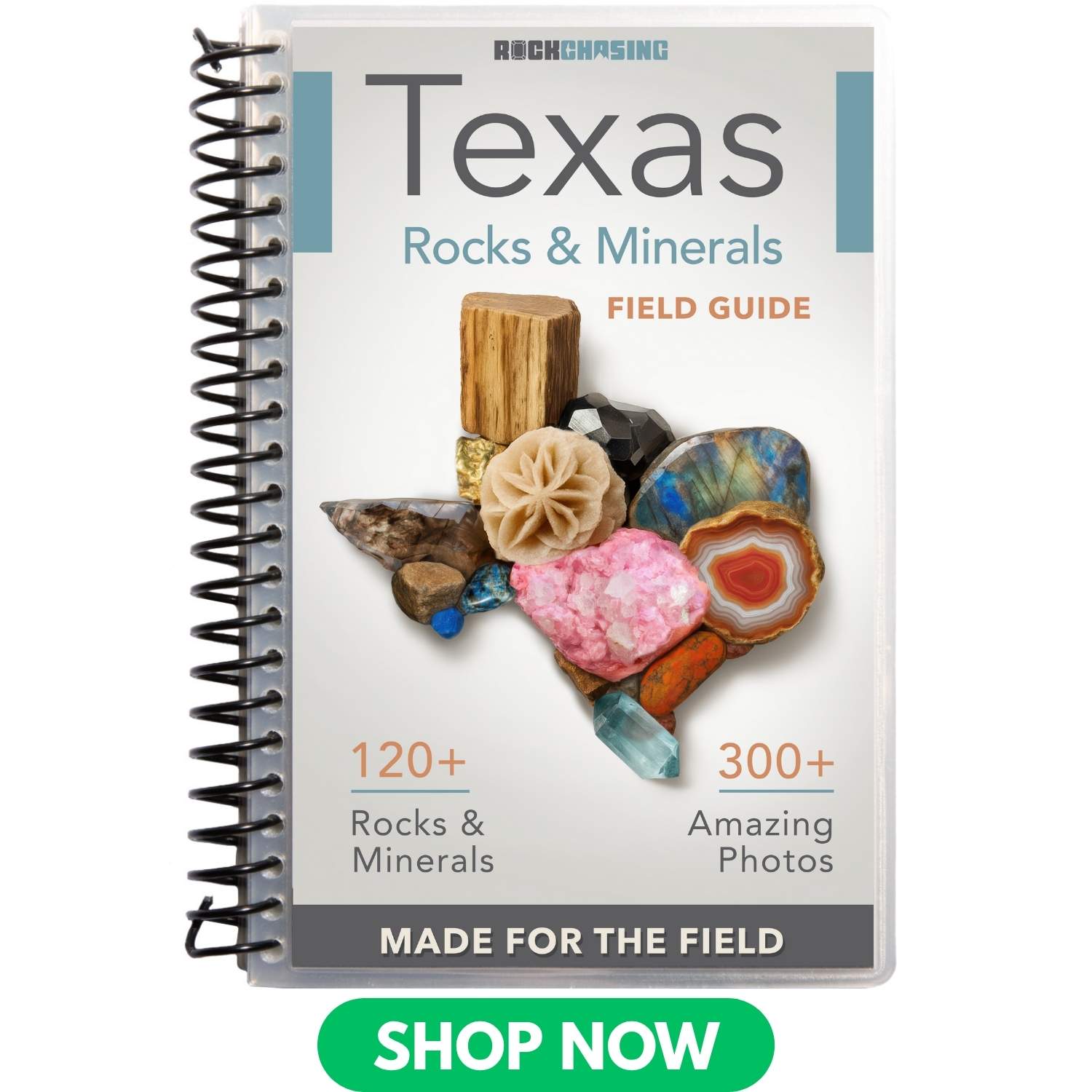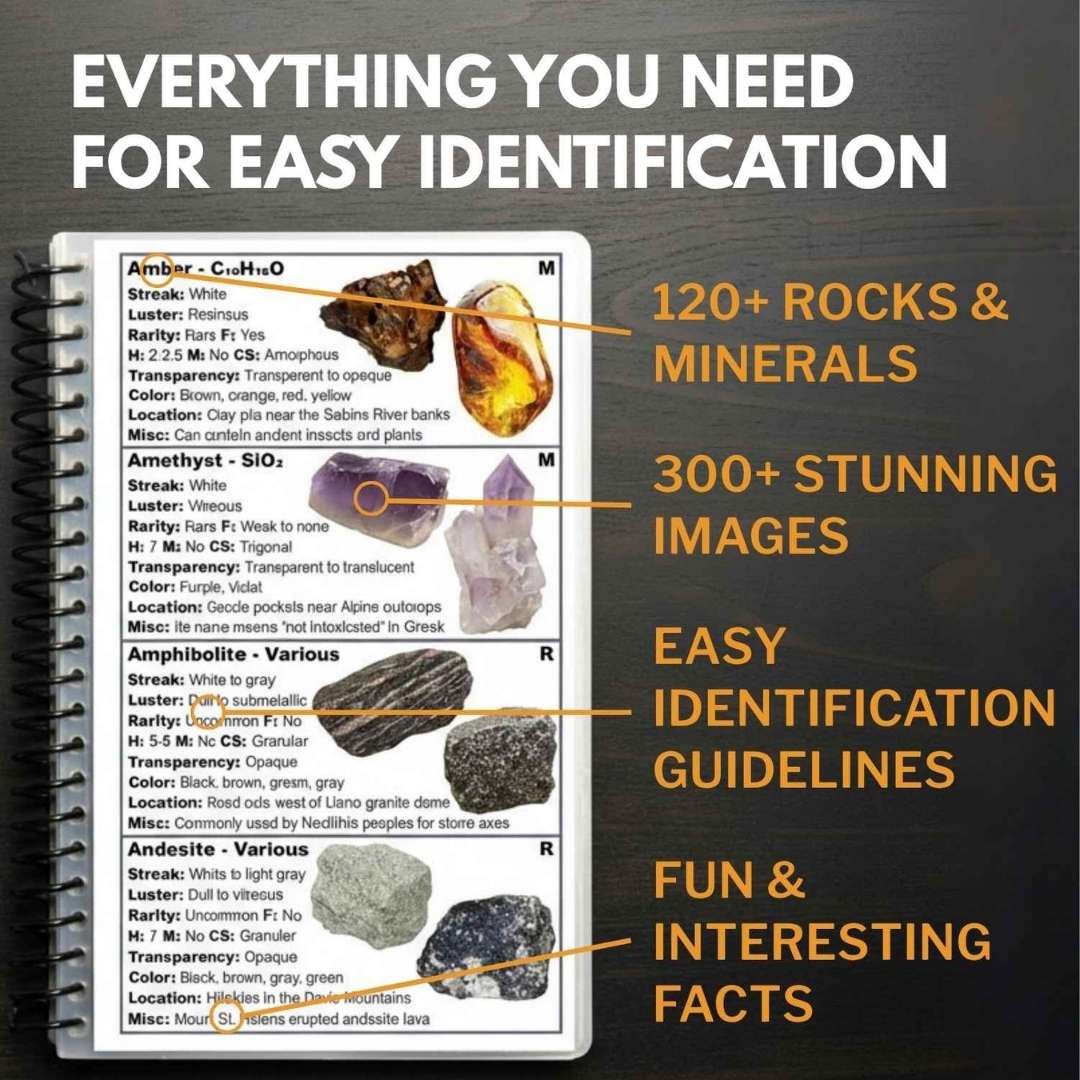Texas has a surprising secret underground: edible truffles that grow far from the famous forests of Europe. These fungi have been found in several parts of the state, especially where tree roots and soil chemistry align just right. If you know what signs to look for, you can find them too.
While Italy has its white truffles and France its blacks, the U.S. is home to species like Tuber lyonii that prefer the Southeast and Southern Plains. In Texas, they’ve been uncovered in pastures, woodlands, and even pecan orchards. But without the right timing, you might walk right past them.
There’s no single map that will tell you where to go. But with the right clues and some local knowledge, you can narrow your search to areas that consistently yield results. The deeper you dig into Texas truffle territory, the more secrets you’ll uncover.
We’ll detail the different locations where you might find these underground treasures. While you’re out there, bring Rock Chasing’s Texas Rocks & Minerals Identification Field Guide so you never walk past an amazing rock or mineral without realizing what you missed.
What We Cover In This Article:
- What Wild Truffles Look Like
- Truffle Lookalikes To Avoid
- Best Practices For Finding Truffles
- Where You Can Find Truffles Around The State
- Other Great Locations For Truffles
- When The Best Time Of The Year Is To Find Truffles
- The extensive local experience and understanding of our team
- Input from multiple local foragers and foraging groups
- The accessibility of the various locations
- Safety and potential hazards when collecting
- Private and public locations
- A desire to include locations for both experienced foragers and those who are just starting out
Using these weights we think we’ve put together the best list out there for just about any forager to be successful!
A Quick Reminder
Before we get into the specifics about where and how to find these plants and mushrooms, we want to be clear that before ingesting any wild plant or mushroom, it should be identified with 100% certainty as edible by someone qualified and experienced in mushroom and plant identification, such as a professional mycologist or an expert forager. Misidentification can lead to serious illness or death.
All plants and mushrooms have the potential to cause severe adverse reactions in certain individuals, even death. If you are consuming wild foragables, it is crucial to cook them thoroughly and properly and only eat a small portion to test for personal tolerance. Some people may have allergies or sensitivities to specific mushrooms and plants, even if they are considered safe for others.
The information provided in this article is for general informational and educational purposes only. Foraging involves inherent risks.
What Wild Truffles Look Like
The U.S. is home to several native truffle species that grow wild in forests across the country. Each one has its own unique scent, appearance, and preferred habitat. Here are the types of truffles you can find:
Oregon Black Truffles (Leucangium carthusianum)
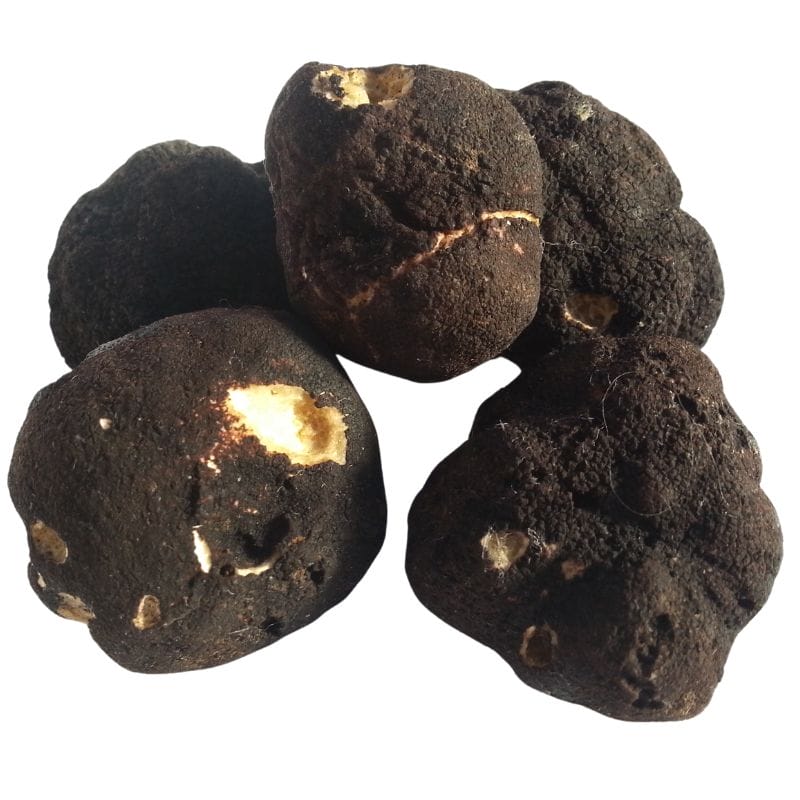
Leucangium carthusianum, also called the Oregon black truffle, grows in the Pacific Northwest and usually shows up around Douglas-fir trees. It’s a native species and one of the more well-known edible truffles from the region.
On the outside, it looks like a small lump of coal—dark black, kind of lumpy or warty, and sometimes slightly smoother in spots. They’re usually about the size of a golf ball, but they can be smaller or larger depending on the season.
Inside, the truffle is firm with a marbled pattern of gray and white veins running through it. When it’s fresh, it smells fruity, almost like pineapple, but the scent gets stronger and muskier as it ripens.
If you’re out looking for them, check in moist, shady forests with soft, loamy soil, especially where there’s a lot of moss or ferns. They grow just below the surface, so people often use trained dogs to help sniff out the ripe ones.
Compared to the Oregon white truffle, which is lighter in color and has a sharper, garlicky aroma, the black truffle has a deeper, more earthy smell. It’s also bigger and firmer than the southern U.S. truffles like Tuber lyonii, which tend to be smaller, paler, and grow around hardwoods like oaks and hickories.
Oregon Winter White Truffles (Tuber oregonense and Tuber gibbosum)
Oregon has two native white truffles that are starting to get more attention: the Oregon Winter White Truffle (Tuber oregonense) and the Oregon Spring White Truffle (Tuber gibbosum). They grow underground in forests and are prized for their strong, savory aroma.
From the outside, these truffles are small, roundish, and kind of bumpy, usually pale beige to light brown. Cut one open, and you’ll see a white interior that darkens with age, showing off a web of white veins when it’s fully mature.
The Winter White Truffle pops up from late fall into February, while the Spring White starts showing up around January and can last into June. They’re pretty similar, but the Winter variety is known for having a more powerful scent and flavor.
To find them, you’ll want to look in forests with younger Douglas-fir trees on the west side of the Cascades. Truffle hunters often check for loose soil or spots where animals have been scratching, which can be a sign there’s something below.
When fully ripe, both types give off a bold smell that’s often compared to garlic, cheese, or earthy spices. They’re usually served raw, shaved over dishes to add that truffle kick without losing any of the aroma.
If you want REAL results finding incredible rocks and minerals in Texas you need one of these 👇👇👇
Finding the coolest rocks in Texas isn’t luck, it's knowing what to look for. Thousands of your fellow rock hunters are already carrying Rock Chasing field guides. Maybe it's time you joined the community.
Lightweight, mud-proof, and packed with clear photos, it’s become the go-to tool for anyone interested discovering what’s hidden under our red dirt.
Join them, and make your next rockhounding trip actually pay off.
📘 Order the Texas Field Guide Now →
What makes it different:
🚙 Field-tested across Texas rivers, ranchlands, and roadcuts.
📘 Heavy duty laminated pages resist dust, sweat, and water.
🧠 Zero fluff — just clear visuals and straight-to-the-point info.
📍 Find hidden gems like Blue Topaz, Texas agate, and petrified wood fast.
⭐ Rated 4.8★ by real collectors who actually use it in the field.
Appalachian Truffle (Tuber canaliculatum)
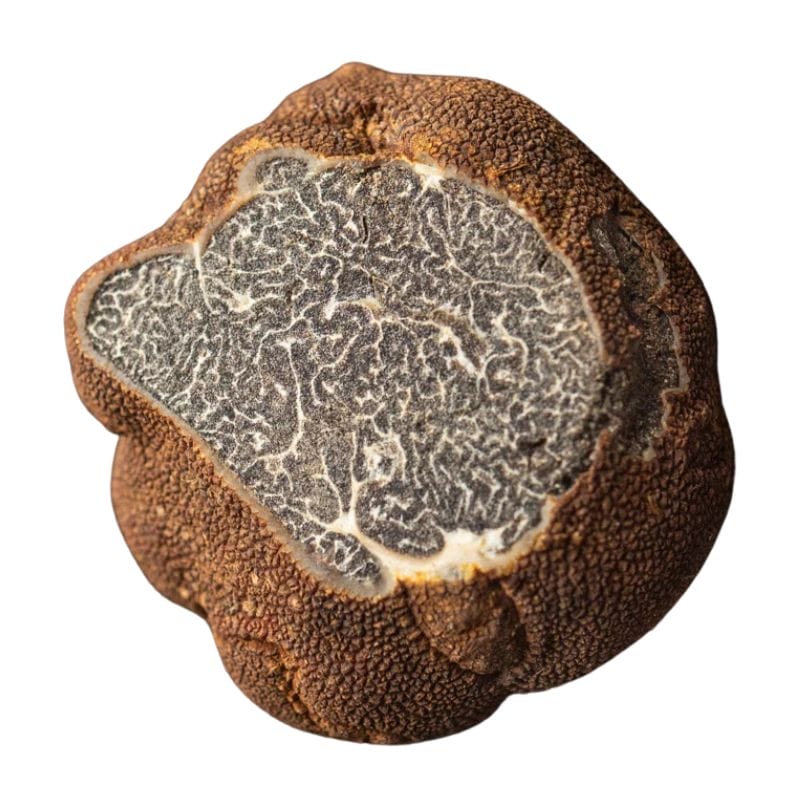
The Appalachian truffle, also known as Tuber canaliculatum, is a native North American truffle that’s slowly getting noticed. It’s about the size of a walnut and has a reddish-brown, bumpy outer surface that looks kind of like a rough, warty potato.
When you cut it open, the inside is firm and dark brown with thin white veins running through it like a marbled pattern. If it’s fully ripe, the smell is strong and earthy—some say it has a kind of nutty, funky aroma that stands out.
You can find these truffles in mixed hardwood forests, especially around oaks and pines, from late summer through fall. They grow underground, so look for spots where the soil is loose and animals like squirrels have been digging—sometimes that’s a good clue.
If you’re foraging, gently raking the top layer of soil near tree roots can help, but a trained dog or even a good nose makes it way easier. Once you know what to look for, the reddish color and bumpy skin are good signs you’ve found the right thing.
Compared to truffles like Tuber oregonense or Leucangium carthusianum, Tuber canaliculatum is more subtle in every way. Its smaller size and lighter scent mean you have to pay closer attention when foraging.
It’s also not as popular in the culinary world because it doesn’t pack the same punch in terms of flavor or aroma. Still, finding one can be rewarding, especially if you’re exploring different types of fungi in the area.
Desert Truffle (Terfezia and Tirmania spp.)
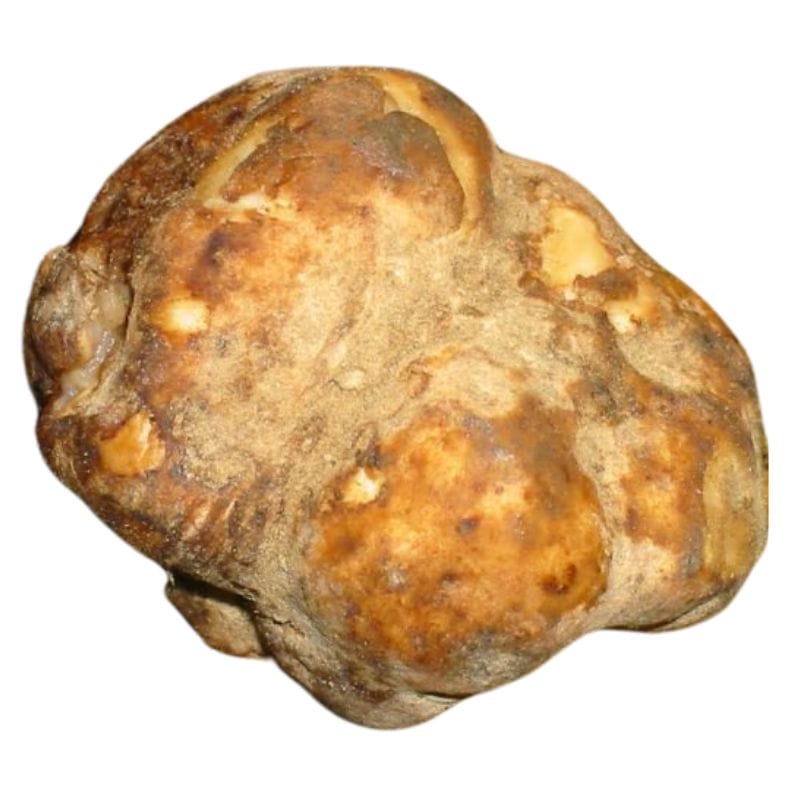
Terfezia and Tirmania are two types of truffles that are sometimes called desert truffles. These are a bit different from the truffles we usually think of, with their bold flavors and rich aromas.
These ones are a little more understated, but they’re fascinating in their own right. What makes them stand out is their ability to thrive in dry, harsh environments where you wouldn’t expect something so delicate to grow.
Unlike the earthy, intense aroma of black or white truffles, Terfezia and Tirmania truffles have a milder scent and flavor. They’re often described as nutty, with a hint of sweetness, but they lack the strong garlicky or musky notes you might associate with other truffles.
Their texture is also different—more firm and less oily than what you’d find with species like Tuber oregonense. They might not have the same culinary punch, but they’re still prized in traditional dishes, where their subtle flavors shine in simpler recipes.
When it comes to appearance, they’re easy to spot once you know what you’re looking for. They’re round to slightly irregular in shape, and their color can range from light beige to a reddish-brown, depending on the species.
The surface is usually smooth or slightly textured, without the rough, knobby look of a black truffle. Cut one open, and you’ll see a pale interior that’s often uniform in color, lacking the intricate veining you’d see in something like Leucangium carthusianum.
Pecan Truffle (Tuber lyonii)
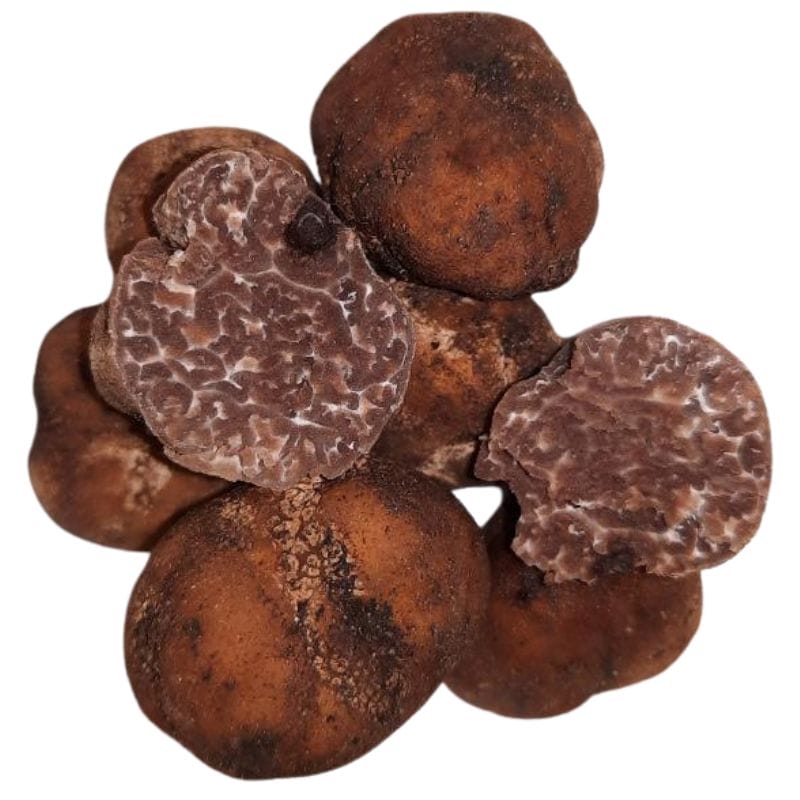
Tuber lyonii, also known as the pecan truffle, is a native North American truffle that grows underground near the roots of pecan trees. You’ll mostly find it in the southeastern U.S., especially in states like Texas, Georgia, and Mississippi.
On the outside, pecan truffles are round to lumpy and have a smooth, light brown skin that darkens as they age. They’re usually about the size of a marble or golf ball, and sometimes they even poke up slightly through the soil surface.
If you slice one open, the inside has a pretty marbled look—light tan streaks mixed with darker brown, almost like wood grain. The smell is earthy, nutty, and kind of warm, especially when they’re fully mature.
When you’re out looking for them, check under mature pecan trees or other hardwoods like oaks and hickories. Trained dogs can help sniff them out, but people sometimes spot them by looking for little cracks in the soil or raised areas near the tree’s base.
Compared to other U.S. truffles like the Oregon white truffle or the Appalachian black truffle, pecan truffles have a milder flavor and are more common in orchards. They’re a solid option in the kitchen—freshly sliced over pasta or mixed into butter—and they don’t come with the high price tag of their European cousins.
Truffle Lookalikes To Avoid
When you’re out hunting you also need to know about a few different fungi species that look very similar to the delicious truffles we’re after but are either inedible or not worth eating. Keep an eye out for:
Pine Truffles (Geopora cooperi)

Geopora cooperi is a fungus that can easily confuse someone new to truffle hunting. It’s sometimes called the pine truffle because it grows underground like a true truffle and often pops up near certain trees.
At first glance, it might seem like you’ve hit the jackpot, but this one is a false truffle, not something you’d want to eat or sell.
The easiest way to tell Geopora cooperi apart from real truffles is by looking closely at its structure. While true truffles have a smooth or slightly knobby exterior and a marbled interior, Geopora cooperi has a rougher, more irregular outer surface.
When it matures, it sometimes splits open, revealing a cup-like shape, which true truffles never do. Inside, it’s less dense and doesn’t have the intricate veining that makes real truffles so unique.
Another big difference is the smell. True truffles have a strong, rich aroma that’s earthy, sweet, or garlicky, depending on the species. Geopora cooperi, on the other hand, has a much weaker scent, and it’s not as pleasant or distinctive.
If you’re relying on aroma to identify your find, this one will give itself away pretty quickly. So, while it might look similar at first, a closer inspection will show it’s not the culinary treasure you’re hoping for.
Stinking Slime Truffle (Melanogaster ambiguus)
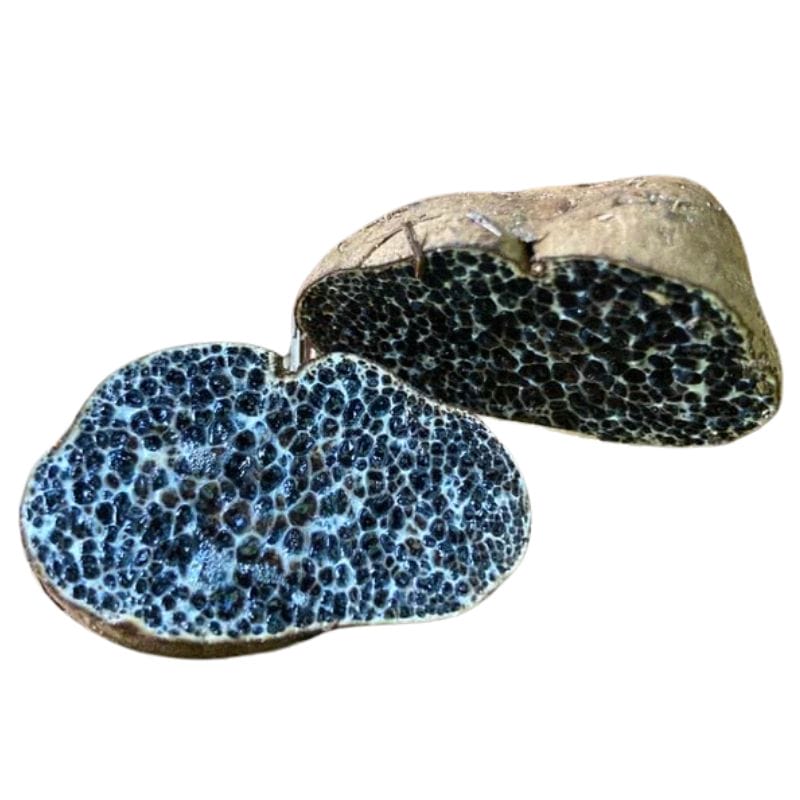
Melanogaster Ambiguus, because of their reddish-brown to dark brown exterior, might look like true truffles at first glance, but they’re quite different when you know what to look for.
The key difference is on the inside. When you cut open Melanogaster ambiguus, the interior is filled with flattened cells that have a shiny black gelatinous feel to them. Real truffles, on the other hand, have those beautiful marbled veins running through their flesh, almost like a web.
Another giveaway is the smell. While real truffles have a rich, earthy aroma that’s mouthwatering, Melanogaster ambiguus tends to have a much stronger, almost unpleasant odor—it’s not something you’d want to sprinkle on your pasta.
Earthballs (Scleroderma)
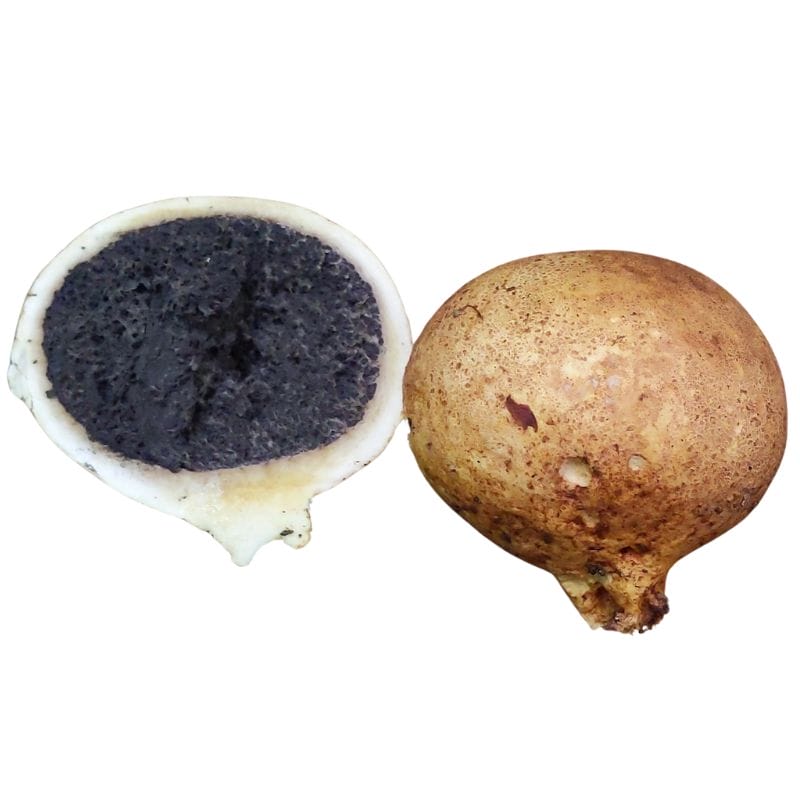
Scleroderma, commonly called earthballs, can easily fool someone who’s just starting out because they grow underground and have a round shape similar to truffles. But don’t be tricked—Scleroderma is not a true truffle, and it’s actually toxic, so it’s important to know how to tell the difference.
The first thing you’ll notice is the outer skin, which is thicker and tougher than that of most truffles. It can range in color from yellowish to dark brown, often with a rough or cracked texture.
If you cut it open, the difference becomes even clearer. While true truffles have a marbled interior with delicate white veins, Scleroderma starts out with a whitish inside that quickly darkens as it matures, turning black or purple with no marbling. It’s dense and solid, almost like charcoal in the later stages.
Another big giveaway is the smell. True truffles have a rich, earthy aroma that makes them so prized, while Scleroderma has little to no pleasant scent—some even describe it as musty or unpleasant.
Deer Truffles (Elaphomyces)
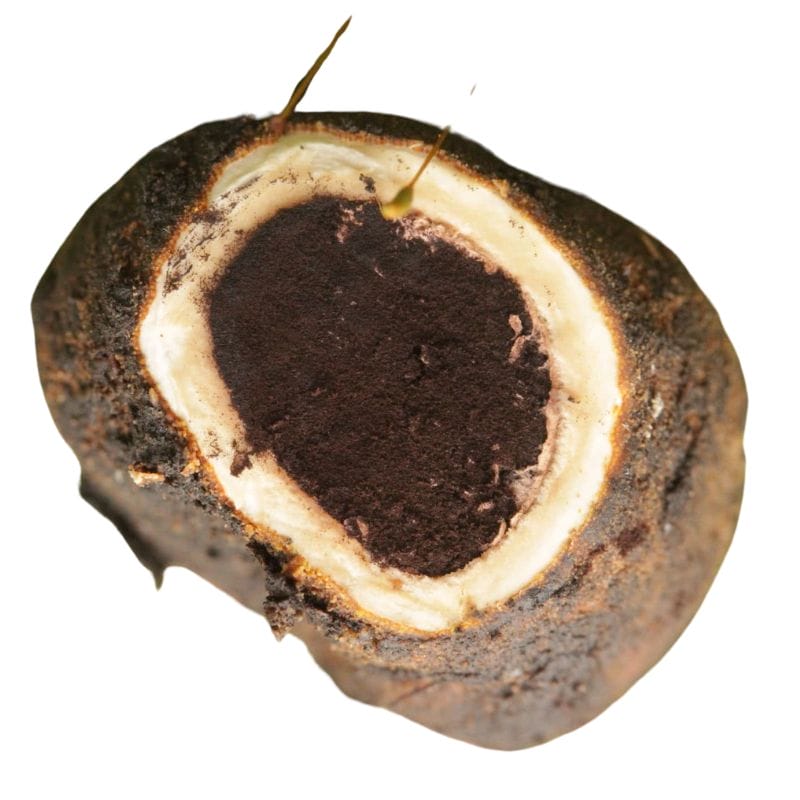
Elaphomyces, also known as deer truffles, look like true truffles at first glance, but they’re a whole different story. They’re called deer truffles because wildlife, especially deer and rodents, love to eat them. For us humans, though, they’re not edible—and definitely not what you want to mistake for a prized truffle.
Here’s how you can tell Elaphomyces apart from the real thing. First, they have a tough, warty outer surface that can range from pale tan to black, depending on the species and their age.
When you cut them open, the inside is solid and sometimes speckled or marbled, but not in the delicate, vein-like pattern you’d see in true truffles.
Their smell is also a big giveaway. Instead of the rich, earthy aroma of an edible truffle, Elaphomyces either has little scent or an odor that’s earthy but not particularly appealing.
Another thing to know is that Elaphomyces often grows deeper in the soil than true truffles, and they tend to have a harder, woodier texture.
Best Practices For Finding Truffles
Truffle hunting can be a rewarding adventure if you know the right tips and tricks. Here’s what you should keep in mind to improve your chances of finding these underground treasures:
Wait 10 to 14 Days After Heavy Rain
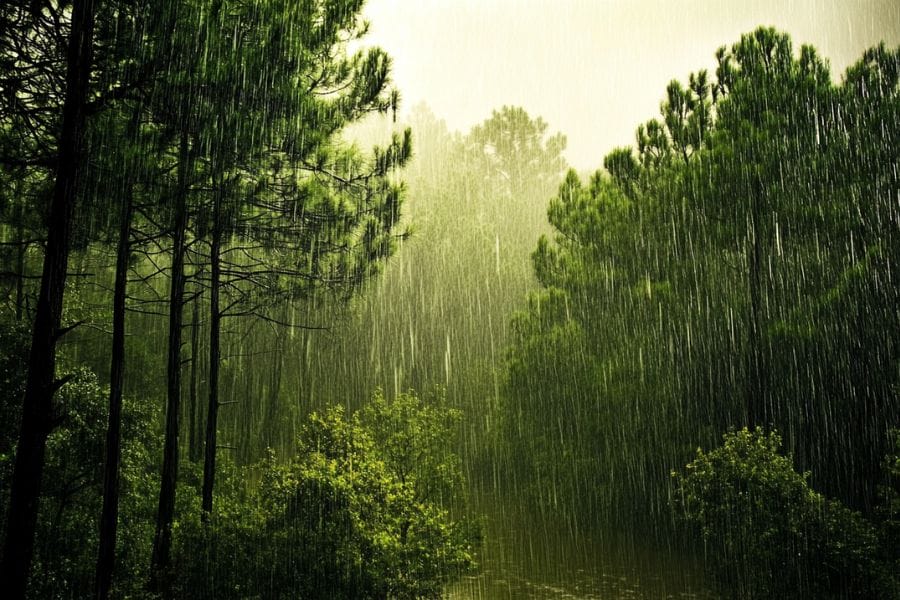
After a heavy rain, it’s best to wait about 10 to 14 days before heading out. This gives the truffles time to mature and release their signature aroma, making it easier for you (and your dog) to sniff them out. Rain helps truffles grow, but they don’t start giving off their scent right away.
As the soil warms up, the truffles get more aromatic, and the ground becomes looser, which makes digging easier without disturbing the environment too much. The timing is perfect to find truffles at their best—both in quality and in how easy they are to locate.
Find the Right Trees

Truffles don’t grow just anywhere—they have a special relationship with certain trees. You won’t find them under just any tree, so knowing which ones to look for can make all the difference. Some of the best trees to look out for are:
- Pines
- Douglas-firs
- Oaks
- Hazelnuts
- Cypresses
- Willows
For example, if you’re looking for Oregon white truffles, keep an eye out for Douglas-fir trees. California black truffles, on the other hand, are often found near oaks and hazelnuts. The soil around these trees also needs to be slightly alkaline, so it helps to know what kind of ground you’re walking on as well.
Watch for Wildlife Activity
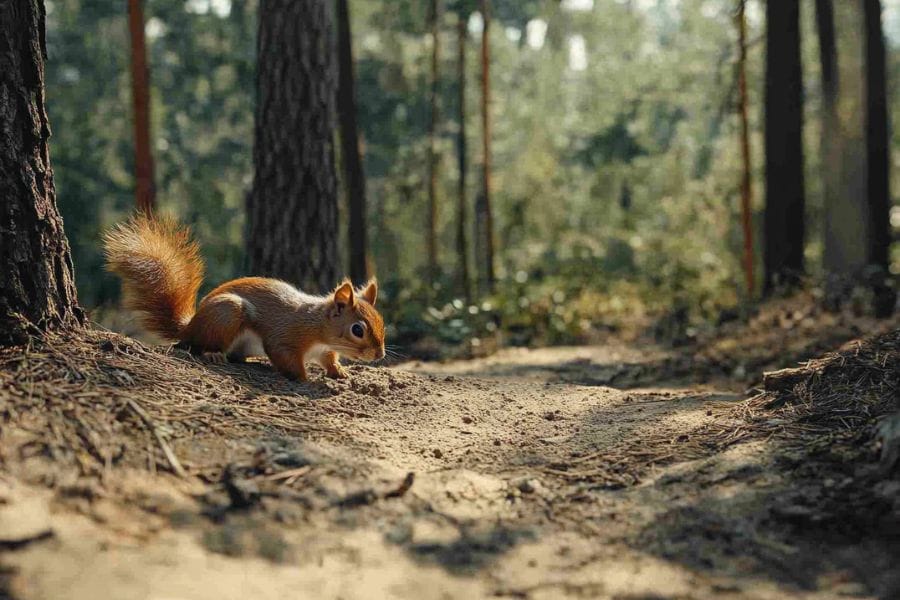
Animals like squirrels and chipmunks often help spread truffle spores, and sometimes their digging can lead you straight to truffles. While you won’t always find truffles in every pit animals dig (they also look for things like acorns or bulbs), fresh digs are a good clue. The more recent the pit, the better chance it has of leading to truffles.
Even though animals are a part of the truffle cycle, most hunters prefer using dogs to find the real treasure underground. Dogs have an incredible nose for truffles and can pinpoint their location much more reliably than any squirrel or chipmunk.
Get a Little Help from a Truffle-Hunting Dog
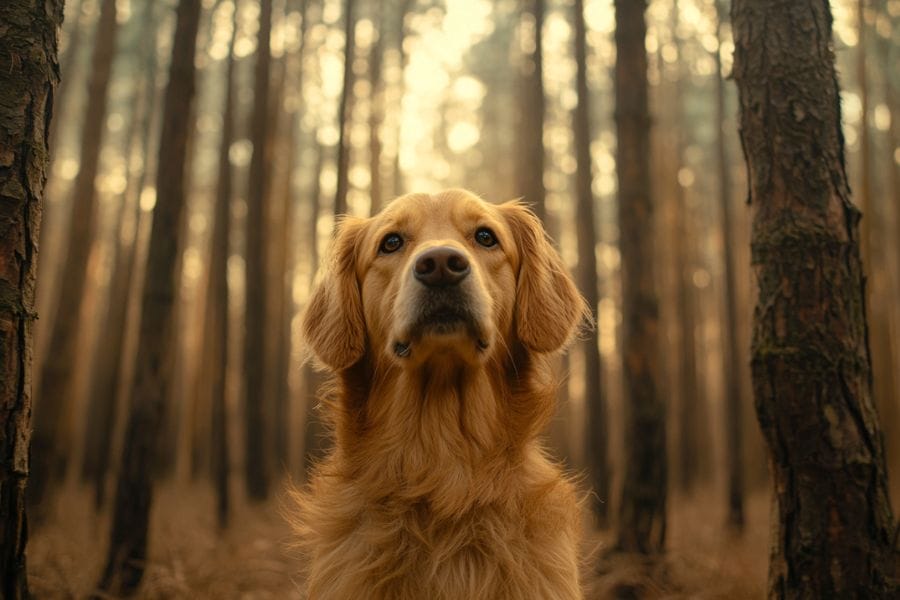
If you’re serious about truffle hunting, a trained dog can make your life a whole lot easier. Their sense of smell is extraordinary, and they’re trained to find mature truffles buried beneath the surface. Many truffle hunters swear by their dogs, and for good reason—they’re much more accurate than humans when it comes to sniffing out truffles.
If you don’t already have a trained dog, you can connect with local foraging groups or specialized trainers who offer truffle-hunting services. Some places even host events where you can see experienced handlers with their dogs in action. And if you’re feeling adventurous, you can train your own dog using truffle-scent kits and practice in a controlled space before hitting the woods.
Before you head out
Before embarking on any foraging activities, it is essential to understand and follow local laws and guidelines. Always confirm that you have permission to access any land and obtain permission from landowners if you are foraging on private property. Trespassing or foraging without permission is illegal and disrespectful.
For public lands, familiarize yourself with the foraging regulations, as some areas may restrict or prohibit the collection of mushrooms or other wild foods. These regulations and laws are frequently changing so always verify them before heading out to hunt. What we have listed below may be out of date and inaccurate as a result.
Where You Can Find Truffles Around The State
Now we’re going to go over five of the best locations for finding truffles. We’ll go a bit in-depth here and then provide a much longer list of other spots to try.
Sam Houston National Forest

Sam Houston National Forest is located about an hour north of Houston. It covers more than 160,000 acres across Montgomery, Walker, and San Jacinto counties. The forest gets its name from the famous Texas general and president of the Republic of Texas.
Tall pine trees make up most of the forest, but you’ll also find areas with oak, magnolia, and sweet gum trees that create perfect spots for truffles to grow. The soil here is slightly acidic and full of organic matter from years of fallen leaves.
The eastern section near the Lone Star Hiking Trail offers promising grounds for truffle hunters. Look for areas where the ground appears slightly raised or cracked. These mounds often show where truffles grow underground.
Bring a small rake to gently move aside the top layer of soil. Focus on north-facing slopes where the ground stays cooler and damper. Trees with few plants growing around their bases often have more truffles because there’s less competition for nutrients in the soil.
You've probably walked past some incredible rocks and minerals. You need this guide 👇👇👇
We've all come across a cool rock that we could have sworn was rare or valuable but couldn't tell what it was.
If you're not 100% confident that you know every rock and mineral in Texas this guide is for you.
The Texas Rocks & Minerals Field Guide helps you ID what you find in seconds, from Hill Country agates to Llano granite, with crisp photos, simple charts, and zero fluff.
→ Grab your copy today and spot your next gem before anyone else does.
What this guide unlocks:
🧭 Confidence in the field — ID rocks fast and move on to the next find
🎒 Lightweight and waterproof — built for trails, not coffee tables
🌅 Weekend adventures — find treasures on rivers, ranches, and roadsides
🤠 Texas pride — explore the real geological beauty of your state
🔥 Motivation — every trip outside feels like a hunt for hidden gems
Angelina National Forest

Angelina National Forest sits in East Texas between the towns of Lufkin, Jasper, and San Augustine. Unlike some other forests, Angelina features lots of water, including the Neches River that runs through it and borders Sam Rayburn Reservoir.
The soil here contains sand mixed with clay that drains well but still holds moisture. Seasonal creeks throughout the forest add extra water that helps truffles develop. The southwestern region, with its many oak and hickory trees, has produced good truffle finds.
Look for truffles around older trees with minimal undergrowth. The area near Boykin Springs is especially good because the soil contains more calcium. Truffles form relationships with tree roots, so search within a few feet of large trees.
Black truffles usually grow deeper than white ones, sometimes 3-5 inches below the surface. Try checking around rotting logs and stumps where lots of nutrients collect.
Davy Crockett National Forest
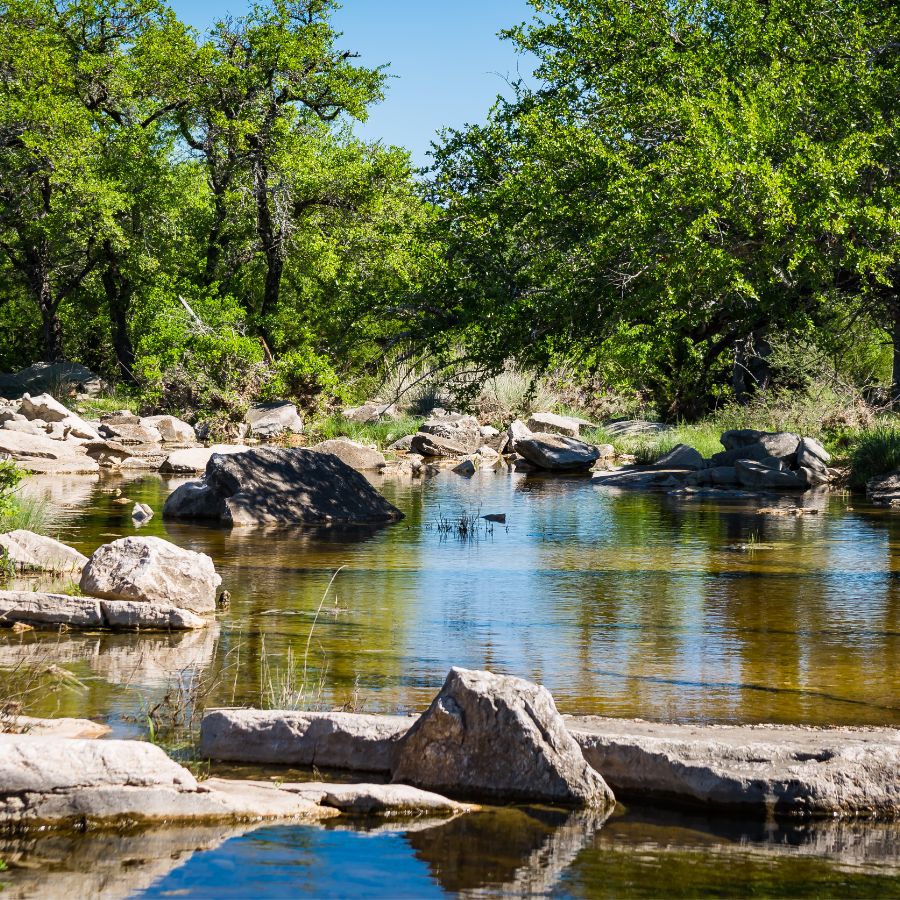
Davy Crockett National Forest is located in East Texas between the towns of Crockett and Lufkin. Visitors enjoy the mix of pine trees and hardwoods that create diverse habitats. The forest’s rolling hills and small streams create different moisture levels throughout the area, which helps various types of fungi grow.
Truffles grow best in the forest’s rich sandy loam soil. This soil drains well but holds enough moisture for fungal growth. The Ratcliff Lake Recreation Area has several good truffle spots nearby.
When hunting for truffles here, focus on mature oak clusters in low areas where moisture collects. The 4C Hiking Trail passes through excellent truffle territory where the forest floor has lots of decomposing leaves. This dead plant material feeds the underground networks that produce truffles.
Sabine National Forest
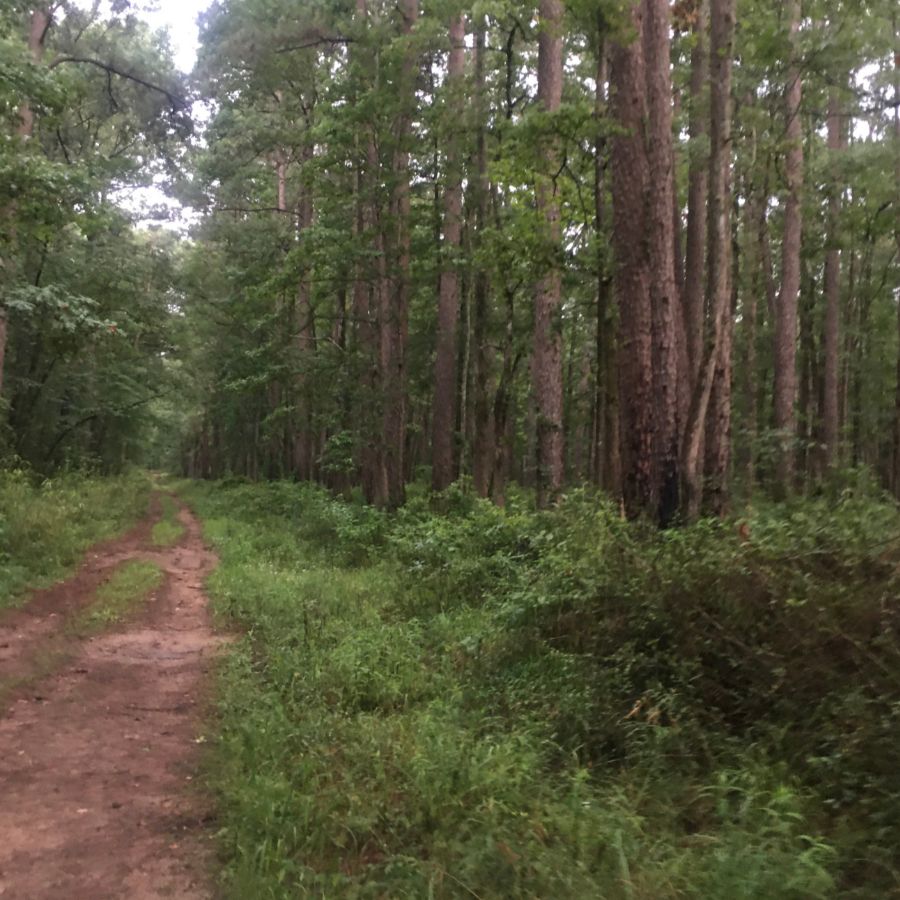
Sabine National Forest lies along the eastern edge of Texas, right on the Texas-Louisiana border. It covers over 160,000 acres in Sabine, San Augustine, Shelby, Jasper, and Newton counties.
The forest borders Toledo Bend Reservoir, which is one of the largest man-made lakes in the southern United States. This location near water creates higher humidity than other forests in Texas. The extra moisture in the air helps truffles grow.
After heavy rains, check areas where water has recently gone down as these spots often have fresh truffle growth. Pay special attention to places with white oak and hickory trees, which commonly form bonds with truffles.
The area around Lakeview Recreation Area has soil with extra calcium that many truffle types prefer. When hunting here, focus on gentle slopes that face south where the soil gets warm but not too dry.
Hunt County Pecan Orchards
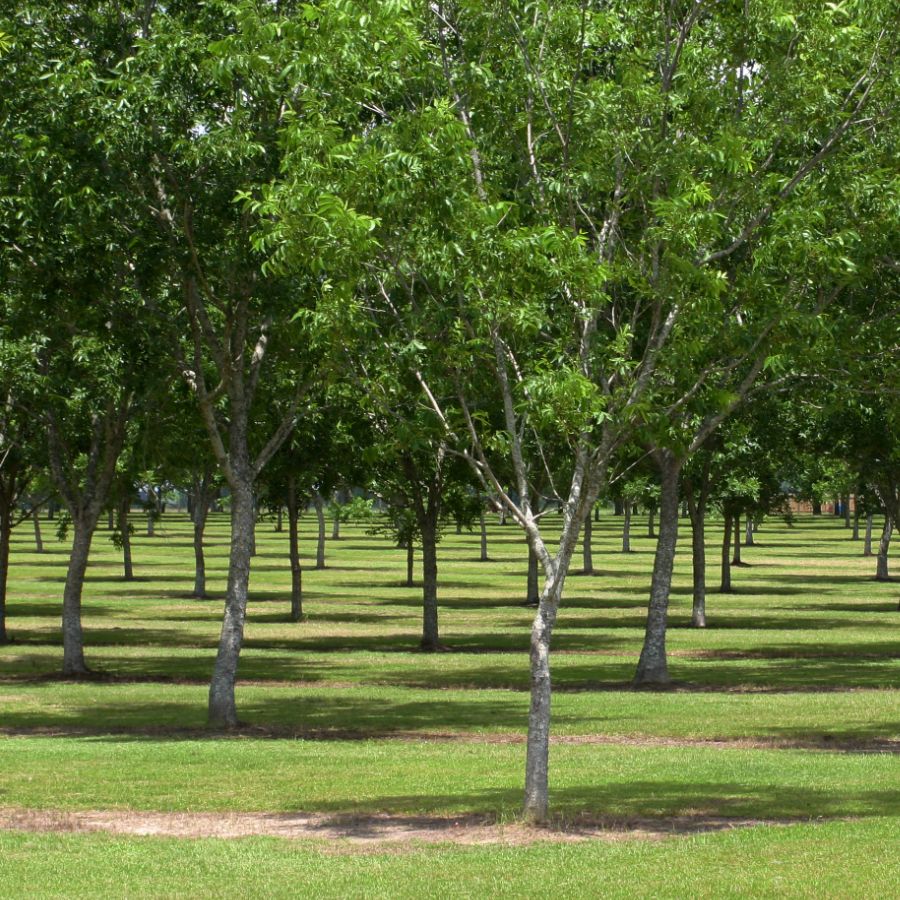
Hunt County is located in Northeast Texas, about an hour east of Dallas. The county seat is Greenville, and the area is known for its rich farmland and pecan orchards. Unlike the national forests, these are working agricultural lands where pecan trees are grown in neat rows.
Many of these orchards have been around for decades, with some trees over 70 years old. The combination of regularly spaced trees, managed soil, and irrigation creates perfect truffle growing conditions.
The older orchards have developed huge root systems underground. These roots form partnerships with different truffle species. Orchards north of Greenville with loamy soil produce the most truffles.
When hunting here, always ask the owner for permision first since these are private lands. Look around the drip line of mature pecan trees where water naturally falls from the branches. Family-owned orchards near Commerce have both black and white truffle types.
The best hunting happens in orchards that don’t use many chemicals. Try searching after the orchard has been maintained when the ground has been lightly disturbed but not deeply plowed. This slight soil disturbance can reveal truffles that would otherwise stay hidden.
Other Great Locations For Truffles
| East Texas | Truffle Collection Details |
|---|---|
| Angelina National Forest | Permits collection of up to 1 gallon of mushrooms per person per day, including truffles, for personal use. |
| Davy Crockett National Forest | Allows personal collection of mushrooms, including truffles, up to 1 gallon per person per day. |
| Sabine National Forest | Truffle foraging permitted with a daily limit of 1 gallon per person for personal use. |
| Sam Houston National Forest | Individuals may collect up to 1 gallon of mushrooms, including truffles, per day for personal use. |
| Big Thicket National Preserve | Allows collection of up to 1 pint of fruits, nuts, or berries per person per day; truffle collection not specified. |
| Private Pecan Orchards (Various Counties) | Truffle foraging allowed with landowner permission; pecan truffles commonly found under pecan trees. |
| Tyler County Woodlands | Private lands where truffle foraging is permitted with owner consent; known for pecan truffle presence. |
| Jasper County Forests | Private properties allowing truffle collection with permission |
| Nacogdoches County Orchards | Truffle foraging permitted on private lands with owner approval |
| San Augustine County Farms | Private farms where truffle collection is allowed with landowner consent; pecan trees common. |
| Newton County Wooded Areas | Truffle foraging allowed on private properties with permission; suitable for pecan truffles. |
| Shelby County Orchards | Private orchards permitting truffle collection with owner approval; pecan truffles found here. |
| Polk County Forests | Truffle foraging permitted on private lands with consent; pecan and oak trees abundant. |
| Angelina County Orchards | Private orchards where truffle collection is allowed with landowner permission; pecan truffles present. |
| Trinity County Woodlands | Truffle foraging permitted on private properties with owner consent; suitable truffle habitat. |
| Central Texas | Truffle Collection Details |
|---|---|
| Bastrop County Pecan Orchards | Private orchards allowing truffle foraging with landowner permission; pecan truffles found here. |
| Hays County Wooded Areas | Truffle collection permitted on private lands with owner consent; oak and pecan trees common. |
| Travis County Farms | Private farms where truffle foraging is allowed with landowner approval; suitable truffle habitat. |
| Williamson County Orchards | Truffle collection permitted on private properties with owner permission; pecan truffles present. |
| Caldwell County Woodlands | Private lands allowing truffle foraging with consent; oak and pecan trees abundant. |
| Lee County Farms | Truffle collection permitted on private properties with owner approval; suitable for pecan truffles. |
| Milam County Orchards | Private orchards where truffle foraging is allowed with landowner permission; pecan truffles found here. |
| Burleson County Wooded Areas | Truffle collection permitted on private lands with owner consent; suitable truffle habitat. |
| Washington County Farms | Private farms allowing truffle foraging with landowner approval; pecan and oak trees common. |
| Fayette County Orchards | Truffle collection permitted on private properties with owner consent; pecan truffles present. |
| Llano County Woodlands | Private lands where truffle foraging is allowed with landowner permission; suitable for truffle growth. |
| Blanco County Farms | Truffle collection permitted on private properties with owner approval; oak and pecan trees abundant. |
| Burnet County Orchards | Private orchards allowing truffle foraging with landowner consent; pecan truffles found here. |
| Lampasas County Wooded Areas | Truffle collection permitted on private lands with owner approval; suitable truffle habitat. |
| San Saba County Farms | Private farms where truffle foraging is allowed with landowner permission; pecan and oak trees common. |
| North Texas | Truffle Collection Details |
|---|---|
| Hunt County Pecan Orchards | Private orchards permitting truffle foraging with landowner consent; pecan truffles found here. |
| Collin County Wooded Areas | Truffle collection allowed on private lands with owner approval; oak and pecan trees common. |
| Grayson County Farms | Private farms where truffle foraging is permitted with landowner permission; suitable truffle habitat. |
| Denton County Orchards | Truffle collection allowed on private properties with owner consent; pecan truffles present. |
| Cooke County Woodlands | Private lands permitting truffle foraging with landowner approval; oak and pecan trees abundant. |
| Wise County Farms | Truffle collection allowed on private properties with owner consent; suitable for pecan truffles. |
| Parker County Orchards | Private orchards where truffle foraging is permitted with landowner approval; pecan truffles found here. |
| Tarrant County Wooded Areas | Truffle collection allowed on private lands with owner consent; oak and pecan trees common. |
| Johnson County Farms | Private farms permitting truffle foraging with landowner approval; suitable truffle habitat. |
| Ellis County Orchards | Truffle collection allowed on private properties with owner consent; pecan truffles present. |
| Kaufman County Woodlands | Private lands where truffle foraging is permitted with landowner approval; oak and pecan trees abundant. |
| Rockwall County Farms | Truffle collection allowed on private properties with owner consent. |
When The Best Time Of The Year Is To Find Truffles
Winter months offer the best truffle hunting in Texas. December through February provides ideal conditions as the ground cools and moisture levels increase.
Most Texas truffles mature during this cooler season. The mild winter temperatures allow the fungi to develop fully underground. Rain patterns during these months help create the perfect environment.
Fall can also yield some early truffle finds. October and November might surprise hunters in certain areas of the state. The cooling temperatures trigger growth for some varieties.
Always check after a good rain. The moisture brings out stronger aromas that make truffles easier to locate. Your chances of success increase significantly in damp conditions.
One Final Disclaimer
The information provided in this article is for general informational and educational purposes only. Foraging for wild plants and mushrooms involves inherent risks. Some wild plants and mushrooms are toxic and can be easily mistaken for edible varieties.
Before ingesting anything, it should be identified with 100% certainty as edible by someone qualified and experienced in mushroom and plant identification, such as a professional mycologist or an expert forager. Misidentification can lead to serious illness or death.
All mushrooms and plants have the potential to cause severe adverse reactions in certain individuals, even death. If you are consuming foraged items, it is crucial to cook them thoroughly and properly and only eat a small portion to test for personal tolerance. Some people may have allergies or sensitivities to specific mushrooms and plants, even if they are considered safe for others.
Foraged items should always be fully cooked with proper instructions to ensure they are safe to eat. Many wild mushrooms and plants contain toxins and compounds that can be harmful if ingested.

